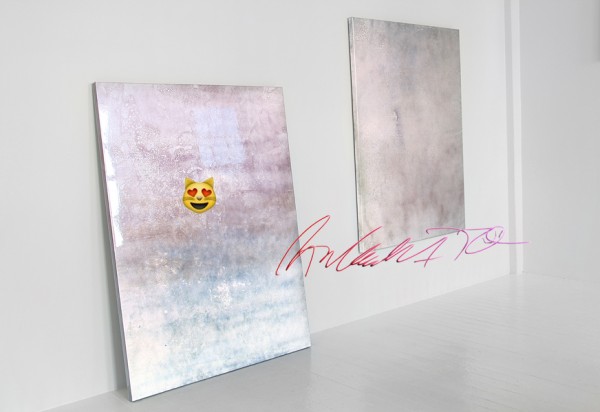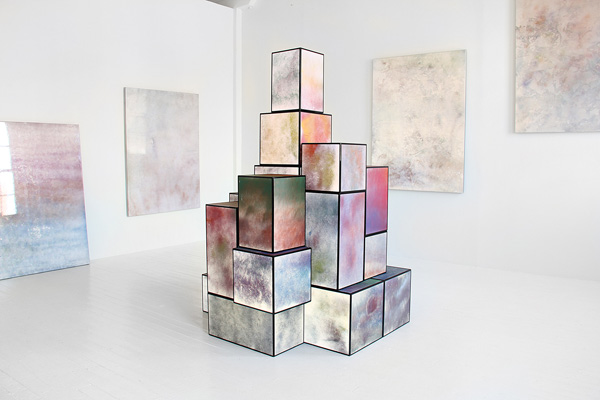Lafayette Anticipation associate curator Anna Colin talks to artist Tyler Coburn about Ergonomic Futures, a speculative project engaged with art, design, science, anthropology and writing. In this interview, Coburn discusses the research, production process and network of collaborators of a multilayered project ultimately concerned with the futures of humankind. Anna Colin: When one comes across your museum seats Ergonomic Futures (2016—) in contemporary art exhibitions—and soon in natural history, fine art, and anthropology museums—they look… [read more »]
Interview with Parker Ito

PARKER ITO | THE AGONY AND THE ECSTASY
STADIUM
548 W. 28th St. Suite 636
New York, NY 10001
SEPT 6 – OCT 6 2012
Parker Ito, as many of you already know, is a multi-media and Internet artist based in the Bay Area. Over the past few years he has become known for his uses and manipulations of found and stock imagery as well as continually re-configuring and jumbling all kinds of online identities, communities, systems and paths of communication. His current solo exhibition at Stadium in New York City titled The Agony and the Ecstasy, features new paintings and sculptures that defy the conventional binary between viewership in the gallery and documentation as it is presented online.
Courtney Malick: I have to start off by asking about the title of the exhibition, The Agony and
the Ecstasy, which of course conjures certain distinct references such as the novel (1961) of the same title about the life of Michelangelo and the subsequent film (1965) based on the book starring Charlton Heston. Then there of also the famous song by Smoky Robinson. Were any of these works in your mind in any way when deciding on a title for this show?
Parker Ito: I like movies, but only bad movies. And I don´t ever read books, only Wikipedia entries. So my knowledge of these things is very superficial. The Agony and the Ecstasy seemed to be a good title for an art show because it kind of encapsulates artistic struggle. My artistic struggles are not so much about, ‘Oh, making art is really hard,’ but more like, ‘I need more money to go online shopping,’ ‘I have a crush on this girl, how do I get her attention on twitter?’ or ‘Do I look hot in this Facebook photo?!’ Online romances are sort of my thing and that´s probably the main theme of this show. When I say “online romances” I don´t just mean girls either, I´m talking about romantic relationships with art via the Internet as well.

CM: Can you tell me a bit more about what you mean by ‘romantic relationships with art’?
PI: Like people artworks seem to exist in some sort of in-between state. Sometimes people take really good photos and sometimes people look hotter offline. I heard a rumor that I’m hotter in person. More so now than ever things exist in multiple versions and one is not truer than the other. Most artworks seem to look better online and lots of art objects can be underwhelming and unromantic in person.
CM: Yes, that is definitely true for photos and other two-dimensional work. I am also really interested in the idea of the exhibition trailer that was included as a link in the press release that I received via e-mail. This is a PR technique that I have never seen before. Is it something that you conceived of as a preemptive extension of the exhibition or is it something that the gallery has done in the past? Also, what was it that you wanted to convey in the trailer that you felt would intrigue people to come see the show in person?
PI: Maybe not in a blue chip sense, but more so with a lot of younger artists exhibition trailers seem to be pretty common now. Mark Leckey made some pretty cool trailers for his exhibitions. Hopefully people will get excited about coming to my show when they see the trailer. That’s probably what I was thinking about most. We live in a day in age of TL;DR though, so who wants to read a whole press release when you can watch a video and get more of a sense of what the show is about? You do´t even have to watch the whole trailer, which is cool too, you can just scrub through it.
CM: I guess that is true to an extent, but I actually found a lot of things in the press release that intrigued me that I doubt I would have understood about the show based solely on the trailer. Most importantly the press release describes a lot about the conceptual background for this body of work, but I would really like to hear from you how it came about, especially as it relates or diverts from your previous work?
PI: Twenty-twelve was all about making beautiful things – my motto this year is ‘be pretty, make pretty things.’ That was the genesis of this body of work. Then I got this idea to try and create artworks that were un-documentable, and then this basically shifted into trying to make art objects where the content of the work was the documentation and that had multiple, unique viewing experiences. Reflective material offered all of these qualities and I just jumped into that head-first. The timing was so perfect, as reflective material seems to be really trending in fashion right now. This makes me feel like I´m the artistic equivalent to hypebeast or something.

CM: I love the idea of documentation as content too and it is clearly foregrounded in this project. Can you say a bit about why you have chosen to set it up in this way?
PI: Yes this is the most important thing. When buying a painting or a sculpture collectors always ask “which is the artists favorite?” My answer would be that my favorite is all the of the paintings and sculptures together, with multiple documentation of each object collected on my website, then a link to my website posted on Facebook with at least 50 likes. I think that´s probably most simple way to explain my reasoning.
CM: From what you have told me so far I am curious to know if you consider this project to be a formal one or if you see it as being rooted in the conceptual? Perhaps in this case we cannot distinguish between the two?
PI: I´m not a conceptual artist, but I think this work is rooted in “konceptualism” and this is similar to when people spell the word “cool”, “kewl”, or “kool”. I am passionate about the Internet and making work about the effects that Internet has had on traditional art objects is the most honest thing I can do, even if sometimes I do that under another name. These paintings and sculptures are made flat, un-stretched. Water and paint is sprayed on to the reflective material, which leads to very randomized results. This reduces the whole process into something very systematic, which yields a very formal result. But the qualities specific to the materials make the experience of viewing these works in person and in documented form very unique, and this is the more “konceptual” side of the project.
CM: Wow, I’ve never thought of a kind of renewed or “off-brand” version of conceptualism. It is interesting that you mentioned wanting to achieve a certain beauty with these works yet on the other hand you would be most pleased to see them reduced to a popular link on your Facebook page. Again, the tension between agony and ecstasy or form and concept seems to arise. Do you feel it is that dichotomy that the works embody that will continue to make them compelling in a non-visual sense once the gallery show is over?
PI: Most conceptual artists claim to be intellectuals. I am either a super anti-intellectual or a fake pseudo-intellectual. Just in the same way that my life is more conceptual than any art, therefore I do not need to make conceptual art. Multiplicity is an important part to the project – a gallery viewer could see these objects in person and think “wow these are extremely beautiful” and the works would just be reduced to pretty things on a wall. Someone could see a low res cell phone pic on Facebook that is extremely blown out and actually have no understanding at all of the formal characteristics of these works. So these objects both reject and accept their own beauty. The most interesting way to experience them is to live with them because one can view them in every lighting condition.

CM: Clearly one of the problemics your show addresses is the dichotomy that exists between experiences that take place online as opposed to offline. Offline, in terms of an art exhibition, would traditionally mean the ‘separate-ness’ of the white cube of the commercial or museum gallery. However, I am beginning to wonder if we can even make such a distinction any longer, as most of us spend each day with a smart phone in our hand at all times, through which we are continuously connected to the internet and various social media networks. It is this perpetually connected condition that makes me wonder if the “unaffected”, (as it is referred to in the show’s press release), space of the gallery can any longer actually be considered as such? Do you think that virtual and physical space necessarily operate differently? And if so, do you think that there will eventually be a time when they will merge completely?
PI: Yea I mean this is already happening. The best way to understand this is if you think about the new Apple OS and how the default track pad settings actually function in reverse from the previous settings. This is because people are getting so used to being on smart phones all the time and scrolling the opposite way is actually more natural. Or things like how Instagram filters just look like Instagram filters and don´t even reference film anymore.
CM: I know what you mean, particularly about Instagram’s self referential filter aesthetic. It is clear to me that it is this condition that your show references, what I am wondering is whether you feel that by presenting something (these paintings) that cannot as easily transition from the real to the virtual realms, does this project represents a critical perspective on this hyper way of interacting via new technologies?
PI: No. I think I’m just being honest about the impact of the Internet on contemporary culture. I mean right now I’m writing this on my iPhone on an abbreviated version of gmail because my laptop is broken and I’m traveling. it takes me longer to type and the experience of handwriting my responses would be very different but it’s still “me.”
CM:Right, of course. I guess my last question would be if other than the documentation existing as the final state of this show that will be accessible on your website, do you have other plans for ways to extend or re-use the documentation “works” that will be the result of The Agony and the Ecstasy?
PI: I don’t really see an end because this work could be re-blogged forever and each time the work is photographed it is reactivated.












































































